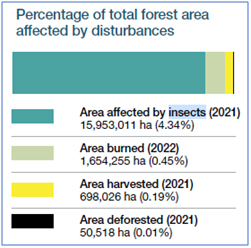According to the Global Carbon Budget project, there were 40 billion tonnes of anthropogenic CO2 emissions worldwide in 2023.
About 10 billion were absorbed by the oceans, which leads to their acidification, 12 billion were absorbed by forests to become new biomass, and the remainder stayed in the atmosphere, increasing global warming. This shows how important forests are in fighting global warming and ocean acidification.
In 2023, some big numbers were in the Canadian headlines: 18.5 million hectares of Canadian forest burned, and the federal government reported progress on the Two Billion Trees (2BT) program. But how can we quantitatively compare burnt hectares of forest and trees planted to fossil emissions? After some research, I put together some numbers for order-of-magnitude estimates of these quantities for comparison, expressed in tonnes of carbon (on a logarithmic scale). Green bars are carbon storage and red are emissions (converted from tonnes CO2e to tonnes carbon for easy comparison).

The total amount of carbon stored in the world’s forests is estimated at 861 billion tonnes, of which about 9.0% are in Canada, at 78 billion tonnes. The Canadian Council of Forest Ministers (CCFM) estimates that a hectare of mature Canadian forest absorbs 6.4 tonnes of CO2 annually, thus storing 12/44 × 6.4 = 1.7 tonnes C/ha. Multiplied by the area of Canada’s forests, 367 million ha, this gives 641 million tonnes of carbon absorption, so in accounting terms, that’s an annual growth rate of about 0.8%.
For the two billion trees that Canada has pledged to plant over the next ten years, if we assume a density of 1500 trees/ha (a reasonable order-of-magnitude estimate), we get 1.3 million ha of afforestation, and at 1.7 tonnes C/ha at maturity, the 2BT absorb 2.3 million tonnes of carbon annually, increasing the existing absorption capacity of Canada’s forest by a mere 0.36%. But of course it will take several decades for the 2BT to reach maturity! To put the 2BT into perspective, Canada’s forest sector already replants any area it harvests, planting roughly 600 million seedlings each year; over ten years this is six billion trees!
Now let’s look at the emissions side of the story. Canada’s GHG emissions in 2021 (the most recent year of official results) were 670 million tonnes of CO2e. This is equivalent to 183 million tonnes of carbon. In accounting terms, this represents a loss of 0.23% when compared to the amount of carbon in Canada’s forest carbon bank, which doesn’t sound too bad when compared to the previous figure of 0.8% annual growth rate.
Unfortunately, however, this is only part of the story and represents an ideal situation where the forests are healthy. This is not the case, due to increasing insect damage and wildfires as a consequence of climate change. The record-breaking 2023 Canadian wildfire season is estimated to have destroyed 18.5 million hectares of forest, resulting in an emission of 480 million tonnes of carbon, or 1.76 billion tonnes of CO2e. Viewed in accounting terms, Canada’s forest-stored carbon went down by 0.48/78 = 0.62%, more than 2½ times the 2021 Canadian carbon emissions from the previous paragraph!
 The area of forest disturbed by insects, such as spruce budworm, jack pine budworm, mountain pine beetle, spongy moth and spruce beetle has increased dramatically over the last 30 years, in part because of a higher survival rate of insects during warmer winters. As shown here, in recent years, the number of hectares affected by insects has been far larger than the area burned in wildfires. Trees killed by insects lead to a loss of carbon stocks and also make forests more vulnerable to wildfires, but estimate the results in accounting terms is very complex. The Canadian Forestry Service (CFS) has a team dedicated to building and maintaining the Carbon Budget Model of the Canadian Forest Sector (CBM-CFS3), a very detailed model that takes into account granular data such as tree species, location-dependent growth rates, effects of forest management, emissions from dead organic matter and disturbances such as fire and insect infestation. The model is continuously adapted using data from forest monitoring and remote sensing.
The area of forest disturbed by insects, such as spruce budworm, jack pine budworm, mountain pine beetle, spongy moth and spruce beetle has increased dramatically over the last 30 years, in part because of a higher survival rate of insects during warmer winters. As shown here, in recent years, the number of hectares affected by insects has been far larger than the area burned in wildfires. Trees killed by insects lead to a loss of carbon stocks and also make forests more vulnerable to wildfires, but estimate the results in accounting terms is very complex. The Canadian Forestry Service (CFS) has a team dedicated to building and maintaining the Carbon Budget Model of the Canadian Forest Sector (CBM-CFS3), a very detailed model that takes into account granular data such as tree species, location-dependent growth rates, effects of forest management, emissions from dead organic matter and disturbances such as fire and insect infestation. The model is continuously adapted using data from forest monitoring and remote sensing.
In this attempt to represent Canada’s forest carbon account in simple terms, I chose numbers that come from reliable sources and used reasonable assumptions. For more details, I encourage you to read CFS’s 2023 Annual Report on The State of Canada’s Forests.
 Martin Fairbank, Ph.D. Martin Fairbank has worked in the forest products industry for 31 years,
Martin Fairbank, Ph.D. Martin Fairbank has worked in the forest products industry for 31 years,
including many years for a pulp and paper producer and two years with
Natural Resources Canada. With a Ph.D. in chemistry and experience in
process improvement, product development, energy management and lean
manufacturing, Martin currently works as an independent consultant,
based in Montreal. He is also an author, having recently published
Resolute Roots, a history of Resolute Forest Products and its
predecessors over the last 200 years.
Martin Fairbank Consulting
Industry Experience
- Pulp and Paper Technology
- Materials Recycling
- Biorefinery Development
- Manufacturing
- Government Subsidy Programs
Services
- Technical Writing
. White Papers
. Grant Applications
. Explain technical concepts - Scientific Editing
. Review of articles for publication - Project Assessment
. Evaluation of Technologies
. Project evaluation for funding agencies - Pulp & Paper
. Conventional and emerging technologies













